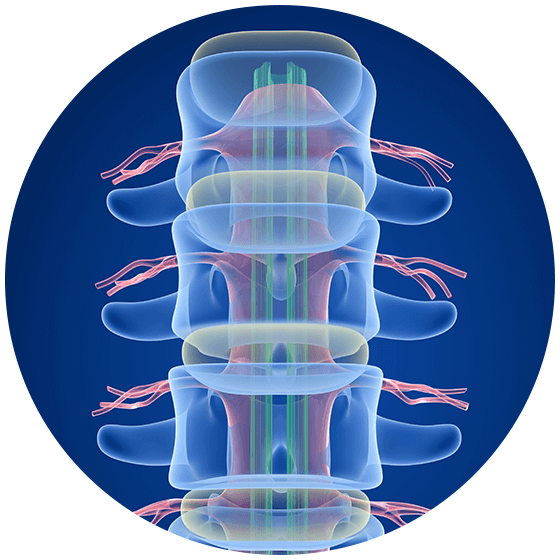Annular Tear

Annular Tear Symptoms & Treatment Options
Annular tears can have symptoms that are very similar to bulging or herniated discs. However, disc tears do not usually produce symptoms unless the outer area of the disc is damaged or a spinal nerve becomes pinched.
If you or someone you know is experiencing an Annular Tear, the following symptoms may emerge:
Annular tears cause localized or “discogenic” pain
Radiating pain may also travel into the arms, legs, hands, or feet
Muscle weakness can occur if lumbar or cervical nerves become pinched
The limbs may also tingle or become numb
Pain is often worse while sitting, bending, lifting, or twisting
Symptoms of an Annular Tear
Sound like you? Contact our award-winning team of spine experts to receive minimally invasive and conservative treatments for disc pain!
Causes of an Annular Tear
Annular tears often result from gradual wear and tear or sudden, traumatic injury. The factors leading to an annular tear are usually as follows:
Degenerative Disc Disease (DDD): DDD occurs when the spinal discs begin to break down, or degenerate, from excess wear and tear. Often this coincides with a loss of fluid inside the disc, a normal facet of the aging process. As the disc begins to dry out, it also loses some of its flexible nature. This ultimately makes the disc more prone to tearing.
Bone Spurs: Bone spurs are bony knobs that form along the endplates of our bones in response to inflammation. Although not “bad” in and of themselves, bone spurs can cause annular tears if they extend into the disc space.
Traumatic Injuries: Sports collisions, car accidents, and falls… Each of these events can cause instantaneous damage to a spinal disc.
Overuse: Repetitive, heavy lifting and occupations that place chronic strain on the back (like sports, nursing, or construction) can lead to annular tears.
Genetics: Your genes often determine the strength and quality of your collagen, the substance that makes up the annulus. Poor cartilage production or inferior collagen can make annular tears more likely.
Worried that you might have an annular tear? Contact our disc experts at the Advanced Spine Center! Dr. Charles Gatto, MD specializes in annular tears, bulging discs, and disc herniations. For superior spine care that you count on, contact the Advanced Spine Center today!
Types of Annular Tears
It seems that annular tears would occur in a fairly straightforward way. The disc itself becomes weak and/or a force causes the disc to rip. And, while this may be true, annular tears can actually occur in 3 different patterns. (Although you might be asking… Who cares if an annular tear is radial vs. concentric? How the disc tears actually reveals quite a bit about the symptoms that will emerge). The 3 major types of disc tears include:
Transverse Tears: Transverse tears begin in the outermost rim of the disc and can extend all the way to the nucleus. This is significant because the outer ? of the disc is highly innervated with pain receptors. If you experience an annular tear here, it’s fairly difficult not to notice.
Radial Tears: These tears begin at the innermost portion of the annulus and can continue to crack until they reach the rim. Because these tears begin in the center of the disc where pain receptors are sparse, they do not always cause symptoms.
Concentric Tears: Concentric tears develop in a ring that encircles the nucleus of the disc. They are often the result of torsional injuries, or twisting the wrong way. (Think of throwing out your back while swinging a golf club.)
How an Annular Tear is Diagnosed
If you suspect that you might have a torn disc, then your doctor will need to perform imaging tests to confirm the presence of the tear. In particular, your doctor will need to order an MRI or CT scan to reveal soft tissues, like spinal discs. Your doctor should also perform a physical examination, which involves palpating (or touching) the spine and investigating any painful areas. Once you have received your diagnosis, your doctor will prescribe a regimen of pain relief options.
Looking for a doctor who can diagnose disc pain? Seek the advice of a board-certified spine surgeon, like Dr. Charles Gatto. Dr. Gatto has over 20 years of experience in resolving annular tears, bulging discs, and disc herniations!